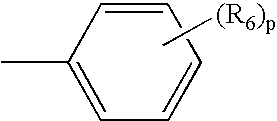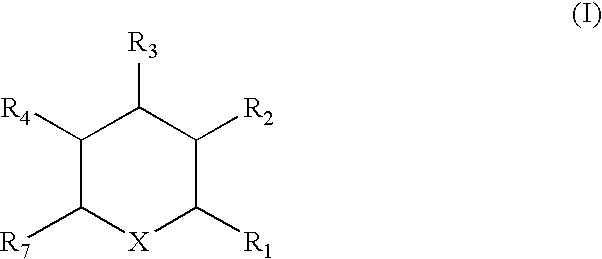Methods of treating conditions associated with an Edg-7 receptor
a technology of edg-7 receptor and biological activity, which is applied in the field of modulating biological activity mediated by the edg-7 receptor, can solve the problems of poor physicochemical properties, limited potential use of pharmaceutical agents of phospholipid compounds, and ineffective discrimination of phospholipid compounds, so as to achieve the effect of modulating the biological activity of the edg-7 receptor
- Summary
- Abstract
- Description
- Claims
- Application Information
AI Technical Summary
Benefits of technology
Problems solved by technology
Method used
Image
Examples
example 2
6.2. Example 2 Compound 131
[0217] (a) 2,4-Diethyl-10,10-dioxo-10H-10.lambda..sup.6-thioxanthen-9-one 14
[0218] Hydrogen peroxide ( 3.0 mL, 29.0 mmol) was added 1 mL at a time to a refluxing solution of 2,4-diethyl-thioxanthen-9-one (0.504 g, 1.88 mmol) in acetic acid (.about.10 mL) and allowed to stir for 2 h. The reaction was cooled to room temperature and allowed to stand 18 h. The reaction was filtered and the resulting yellow, highly viscous liquid was washed with dichloromethane and methanol, then reduced in vacuo. 2,4-Diethyl-10,10-dioxo-10H-10.lambda..sup.6-thioxanthen-9-one (0.381 g, 67% yield) was obtained as a yellow solid after recrystallization from ethanol and was identified on the basis of NMR spectral analysis.
[0219] (b) 2,4-Diethyl-10,10-dioxo-10H-10.lambda..sup.6-thioxanthen-9-one 15
[0220] Zinc amalgam was formed via the addition of zinc (0.956 g, 14.6 mmol) to mercury(II) chloride (0.125 g, 0.46 mmol). To this mixture water (10 mL) was added slowly. Hydrochloric aci...
example 6.3
3
[0221] (a) 2,4-Dimethylthioxanthen-9-one 16
[0222] 1,3-Dimethylbenzene (2.0 mL, 16.3 mmol) was added to a suspension of 2-mercapto-benzoic acid disulfide (0.950 g, 3.10 mmol) in concentrated sulfuric acid (10 mL); the resultant mixture was stirred at 50-55.degree. C. for 1 h. The mixture was cooled and water (150 mL) was added. The resultant solid was filtered and slurried in aqueous sodium hydroxide (0.5 M), filtered and washed with water to afford 2,4-dimethylthioxanthen--9-one (0.565 g, 76% yield), which was identified by NMR spectral analysis.
[0223] (b) 2,4-Dimethyl-10,10-dioxo-10H-10.lambda..sup.6-thioxanthen-9-one 17
[0224] Hydrogen peroxide (30% wt., 3.0 mL, 29.0 mmol) was added dropwise to a solution of 2,4-dimethylthioxanthen-9-one (0.535 g, 2.23 mmol) in acetic acid (.about.10 mL) at reflux; the resultant mixture was stirred 2 h at reflux. The reaction was cooled to ambient temperature, added to water (200 mL) and allowed to stand 48 h. Filtration afforded 2,4-dimethyl-10,1...
example 4
6.4. Example 4
[0227] Selective Inhibition of the Edg-7 Receptor by Compounds 105 and 107
[0228] 101, 105 and 107 are representatives of a series of compounds that demonstrate inhibition of Edg-7 stimulated LPA responses. The compounds were tested in HTC cells expressing human Edg 7 receptors, as well as in HT1080 human fibrosarcoma cell lines that naturally express Edg 7 receptors. The rat hepatoma cell line, HTC, does not express any detectable levels of any of the known Edg receptors. Therefore, HTC proved to be a useful system because Edg-7 could be tested in isolation when recombinantly introduced into these cells. The compounds are tested in this recombinant system first, and subsequently tested in cell lines expressing Edg-7 (in addition to other Edg receptors).
[0229] FIG. 1 demonstrates that 101 specifically inhibit the Edg-7 receptor. 101 did not inhibit LPA-stimulated calcium increases in HTC cells expressing Edg-2 or Edg4 receptors and also did not inhibit S1P-stimulated ca...
PUM
| Property | Measurement | Unit |
|---|---|---|
| molecular weight | aaaaa | aaaaa |
| molecular weight | aaaaa | aaaaa |
| molecular weight | aaaaa | aaaaa |
Abstract
Description
Claims
Application Information
 Login to View More
Login to View More - R&D
- Intellectual Property
- Life Sciences
- Materials
- Tech Scout
- Unparalleled Data Quality
- Higher Quality Content
- 60% Fewer Hallucinations
Browse by: Latest US Patents, China's latest patents, Technical Efficacy Thesaurus, Application Domain, Technology Topic, Popular Technical Reports.
© 2025 PatSnap. All rights reserved.Legal|Privacy policy|Modern Slavery Act Transparency Statement|Sitemap|About US| Contact US: help@patsnap.com



